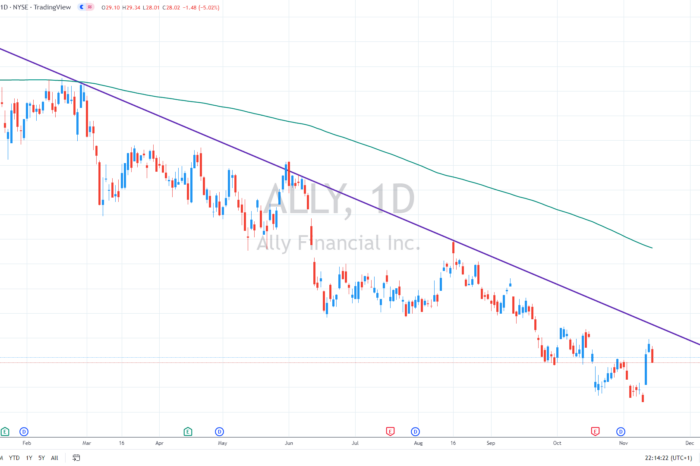Ally Financial provides digital financial services and has both business and corporate clients. It runs Ally Bank, a digital bank that provides auto financing, personal loans, savings, and other banking services in addition to mortgage lending and insurance activities.
In addition, Ally runs consumer credit card operations, securities brokerage, investment consulting services, and corporate financing operations for equity sponsors and middle-market businesses.
Related article: S&P 500 skyrockets after US inflation moderates
On Monday, the stock price closed 5% lower as traders quickly took profits from Friday’s rally in a long-term bear market.
Miserable earnings
Ally Financial announced its third-quarter results on October 19, 2022, significantly underperformed the consensus estimate. With profits of $1.12 vs. the market estimate of $1.73, it underperformed by $0.61. It was the second consecutive earnings shortfall.
Greater net finance revenue was offset by higher provision for credit losses, higher noninterest expenditures, and lower other revenue, resulting in a net income of $272 million as opposed to $683 million a year earlier.
The company’s mortgage division suffered as mortgage rates increased and the housing market cooled.
“Financial results were partially depressed this quarter as a result of an impairment on a nonmarketable equity investment related to our mortgage business, impacting $0.33 of EPS, and higher provisions as a result of loan growth in auto finance and a more extensive coverage build to ensure the company remains protected as recessionary conditions feel more likely to occur in the coming months,” said Jeffrey J. Brown, CEO.
Loan delinquencies rise
According to Zacks Equity Research, Ally’s provision for credit losses grew by $362 million over the previous year to $438 million as a result of credit losses that are normalizing as anticipated and a buildup of CECL reserves brought on by a healthy volume of retail vehicle originations.
The provision for credit losses in the automotive industry significantly increased, rising from $275 million to $328 million yearly. As a result, the retail car net charge-off rate increased by 78 basis points from the previous year to 1.05%.
The long-term trend is bearish, as evident from the daily chart, as the massive downtrend line has been limiting the upside potential for an entire year. The critical resistance, therefore, stands near $30, and if broken to the upside, a sharp rally to the 200-day average at $36 could occur.
You may also read: Is COIN ready to accelerate amid all the crypto chaos?
However, since the fundamental situation of the company remains bearish, we might expect new lows soon. The supports are seen at $26 and $25. If not held, the stock price could drop toward $20.











Comments
Post has no comment yet.